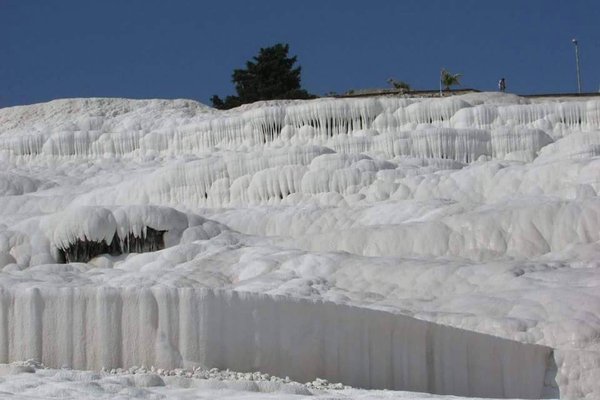Turkiye
Hierapolis-Pamukkale
Hierapolis-Pamukkale was an ancient thermal spa based on natural hot springs.
Pamukkale consists of a striking natural landscape of white terraces with travertines stemming from calcite-rich water from the hot springs. Under Hellenistic and Roman rule, the area became a healing centre using the hot springs for therapies. Religious structures were added as well, a practice that continued into the Early Christian period.
Community Perspective: The calcium terraces of Pamukkale are brilliantly white and still are inviting to bathing tourists (it “can be an absolute circus targeted especially for tour groups”). The ruins of Hierapolis are typical of other Greco-Roman cities, but its excellent location just above the travertine pools and hot springs stands out.
Site Info
Official Information
- Full Name
- Hierapolis-Pamukkale (ID: 485)
- Country
- Turkiye
- Status
-
Inscribed 1988
Site history
History of Hierapolis-Pamukkale
- 1988: Revision
- Includes the former TWHS Hierapolis - a Roman settlement and the necropolis (1984)
- 1988: Revision
- Includes the former natural TWHS Pamukkale Hierapolis (1984)
- 1988: Inscribed
- Inscribed
- Type
- Mixed
- Criteria
- iii
- iv
- vii
Links
- UNESCO
- whc.unesco.org
- Official
-
- muze.gov.tr — Hierapolis Archaeological Site
- Related
-
- pbase.com — Beautiful photos of thepools at Pamukkale
All Links
UNESCO.org
- whc.unesco.org — whc.unesco.org/
Official Website
- muze.gov.tr — Hierapolis Archaeological Site
Related Resources
- pbase.com — Beautiful photos of thepools at Pamukkale
News Article
- Oct. 30, 2013 hurriyetdailynews.com — Aphrodite head found in ancient Hierapolis
- April 3, 2013 csmonitor.com — 'Gate to Hell' unearthed at Hierapolis
- Aug. 2, 2011 news.discovery.com — Tomb of Jesus' Apostle Found In Hierapolis?
- Sept. 9, 2009 dsc.discovery.com — Colossal Apollo Statue Unearthed in Hierapolis
Community Information
- Community Category
- Natural landscape: Volcanic
- Archaeological site: Ancient Greece
Travel Information
One million visitors or more
Izmir Hotspot
Recent Connections
-
Perfect Inscriptions
1988 -
Izmir Hotspot
Izmir - Denizli buses are now only last… -
In Video Games
Civilization VI: Pamukkale
Connections of Hierapolis-Pamukkale
- Individual People
-
-
Gertrude Bell
Photo taken April 1907
-
- Geography
- Trivia
-
-
One million visitors or more
2 million two hundred thousand visitors in 2023 / Hierapolis of Phrygia, 1.8 million (2015) -
In Video Games
Civilization VI: Pamukkale -
Hot Air Balloon rides
Several providers from PamukkaleSee www.viator.com
-
- History
-
-
Hellenistic Greece
Hellenistic spa town of Hierapolis, founded by the Attalid kings of Pergamom at the end of the 2nd century B.C (OUV) -
Byzantine Empire and Civilization
Hierapolis: "During the Byzantine period, the city continued to flourish and also remained an important centre for Christianity." & "The martyrium had a special design, probably executed by an architect of a Byzantine emperor. "(wiki)
-
- Ecology
-
-
Travertine pools
Pamukkale: white travertine terraces -
Significant Karst Features
Possibly the world's earliest karst tourist site still in use. (AB ev)
-
- World Heritage Process
-
-
Perfect Inscriptions
1988 -
Derived from more than one TWHS
Originally two separate nominations (Hierapolis and Pamukkale).
-
- Religion and Belief
-
-
Mentioned in the Bible
Colossians 4:13 - "I vouch for him that he is working hard for you and for those at Laodicea and Hierapolis." -
Nymphaeum
See en.wikipedia.org
-
- Constructions
-
-
Theatres and Opera Houses
Roman theatre -
Latrines
-
Martyrium
St. Philippe MartyrionSee en.wikipedia.org
-
Baths
Spa -
Necropolises
Hierapolis
-
- WHS on Other Lists
-
-
IUGS Geological Heritage Sites
Pamukkale Travertines
-
- Timeline
-
-
Late Pleistocene
Pammukale: age estimations show that travertine deposition started during the late Pleistocene. (Encyclopedia of Caves and Karst Science) -
Built in the 2nd century BC
For its Greco-Roman spa qualities: "they founded a thermal station on the site in the late 2nd century" (AB ev), and Romans from 129 B.C. -
Built in the 4th century
For its Christian monuments: "The Christian monuments of Hierapolis, erected between the 4th and the 6th centuries, constitutes an outstanding example of an Early Christian architectural group" (AB ev, Criterion IV)
-
- WHS Hotspots
-
-
Izmir Hotspot
Izmir - Denizli buses are now only lasts 2.5h, thanks to the new highway. From Denizli city centre to Pamukkale is 15 min by taxi or 30 min by local buses/dolmus.
-
News
- hurriyetdailynews.com 10/30/2013
- Aphrodite head found in ancient Hi…
- csmonitor.com 04/03/2013
- 'Gate to Hell' unearthed at Hierap…
- news.discovery.com 08/02/2011
- Tomb of Jesus' Apostle Found In Hi…
Recent Visitors
Visitors of Hierapolis-Pamukkale
- Adrian Turtschi
- Afshin Iranpour
- Alberto Rodriguez Gutierrez
- Alexander Barabanov
- Alexander Lehmann
- Alexander Parsons
- alicemears
- Alikander99
- Ali Zingstra
- Aljaz
- A. Mehmet Haksever
- Ammon Watkins
- Andrew_Kerr
- andyng-site
- Angela Vandyck
- Argo
- Artur Anuszewski
- Aspasia
- Atila Ege
- Aunti
- AYB
- Bauchat
- bergecn
- Bill Koo
- Bill Maurmann
- Bin
- bossc
- butterflybird
- Can SARICA
- Carlo Sarion
- CeeMon
- Chalamphol Therakul
- Chantal den Haan
- Cheryl
- Chinmaya
- Christian Wagner
- Christine
- christof
- Christravelblog
- Chunsian01
- Clyde
- Corinne Vail
- Csaba Nováczky
- CugelVance
- cwthong
- CynthiaSam
- czesioszpachelka
- Dagmara
- Danny L
- Dan Pettigrew
- David Berlanda
- del
- Dimitar Krastev
- Don Irwin
- Dorejd
- Doubanjiang
- Eirini
- Elaine McArdle
- Elia Vettorato
- Elisabeth Fransisca Situmorang
- eljx1988
- Elliot
- Els Slots
- Emili Xaus
- Erfe91
- Erik Jelinek
- Ertai
- Eva Kisgyorgy
- Evgenii
- Fan Yibo
- Farinelli
- Felicité
- Femke Roos
- Fernweh
- Fmaiolo@yahoo.com
- Francky D'Hoop
- Frédéric M
- FS
- Garrett
- g.emma_bae
- George Gdanski
- GerhardM
- Gernot
- Giannis75
- Gilles
- Grzegorz Andruszkiewicz
- Hadrianus
- Hammeel
- HaraldOest
- Harald T.
- Harry Mitsidis
- Hasco
- H Beswick
- Hdhuntphotography
- henryjiao18
- Hubert
- Hughes1920
- Iain Jackson
- Ivan Rucek
- janameerman
- Jan Korpeg
- Janos
- Jan-Willem
- Jarek Pokrzywnicki
- Javier
- Javier Coro
- Jawnbeary
- Jay T
- Jeffrey Chai
- Jezza
- JL
- J_neveryes
- John Smaranda
- jonathanfr
- Jon Opol
- Judit Andrea Juhász
- Juha Sjoeblom
- Jurre
- KarenBMoore
- Karito Vies
- Kbecq
- KeithBailey
- Ken DJ
- KentishTownRocks
- Kerékgyártó
- Kevin McFarland
- Kevin Padley-Knight
- Kjlauer
- Knut
- Krijn
- Kurt Lauer
- kutasp
- La Concy
- Lado Joel
- Laetitia Yin
- Lembu
- Liamps91
- lichia
- Little Lauren Travels
- Loic Pedras
- Lucas Del Puppo
- Lucio
- Ludvan
- Luis Filipe Gaspar
- Lukasz Palczewski
- Luke LOU
- Lukemarshall
- Maciej Gil
- Maciej Gowin
- Malgorzata Kopczynska
- marc Rouserez
- Martin
- Martina Rúčková
- Marton Kemeny
- maryhattie
- Mateusz
- MaYumin
- Mazeman
- Michael Ayers
- michaelsballard
- Michael Turtle
- Milan Jirasek
- Miloš Tašković
- miri2808
- Mo-han Je
- Monica Tasciotti
- MoPython
- Naim Y
- nan
- Neil McPaul
- Nick M
- Nihal Ege
- opperpco3
- PabloNorte
- palka25
- Paola Laura
- Patrik
- Paul Schofield
- petar
- Philipp Leu
- Philipp Peterer
- phillipmeng
- Pink Bunny
- Piotr Wasil
- pressdm
- puessergio
- Qin Xie
- Rachel Perkins
- Rafał Kałczuga
- Rahelka
- Randi Thomsen
- Reza
- Rick Ohm
- Risson
- RobRos
- Roger Ourset
- Roman Bruehwiler
- Sandmann15
- Sandra!
- Sclowitz
- Sergio Arjona
- sime147
- Solivagant
- Squiffy
- Stanislaw Warwas
- StaziG
- stephhollett
- Svein Elias
- Szucs Tamas
- Tamara Ratz
- Tarquinio_Superbo
- Tcchang0825
- Thomas Buechler
- Thomas Harold Watson
- Thomas van der Walt
- Thorben
- Tikhon Puliaev
- Tim Allen
- Timothy C Easton
- Tonisan
- tony0001
- Traveling Girl
- triath
- Truls Brekke
- Tschibi
- Twobaconsandaboston
- ValiaVeweth
- Vanessa Buechler
- Vernon Prieto
- Viaje al Patrimonio
- Vsacan
- wantrain.
- Wei
- Wieland
- Wimmy
- Wojciech Fedoruk
- Xiong Wei
- Yevhen Ivanovych
- Zoe
- Zoë Sheng
- Zsuzsanna Forray
Community Reviews
Show full reviews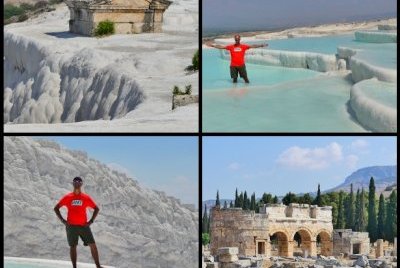
I visited this WHS in Spring 2021. It truly is an excellent example of a mixed site and as such I feel it deserves my 4 star rating. That said, before visiting I had marked Pamukkale as one of my remaining top WHS to visit, but after visiting I can say that I had neglected the Hierapolis component and may have been overenthusiastic on visiting Pamukkale.
I decided on staying 3 nights in the area (2 in Pamukkale and 1 in the nearby Akhan Caravanserai) as my base for visiting Laodikeia tWHS and Aphrodisias WHS too. This turned out to be a good decision as Denizli can be very busy with traffic and starting early helps to beat the crowds. Even though usually Pamukkale is open from 06:30, unfortunately the COVID restrictions for locals meant that the opening hours changed to 8am. Our early start rewarded us with empty pools for the first 30 minutes or so and a better overall experience especially in Pamukkale.
Be warned that Pamukkale alone can be an absolute circus targeted especially for tour groups. Think bus loads of tourists after late breakfast (even during COVID times!), swan paddle boats just beneath the travertine pools, selfie sticks, paragliding and hot air balloons, people posing everywhere, live parrots for "photo opportunities", and a never ending queue of tourists heading mostly to the Cleopatra's Pool hot springs with replica remains. Add to that the metal pieces added to divert the water flow to the pools, …
Keep reading 0 comments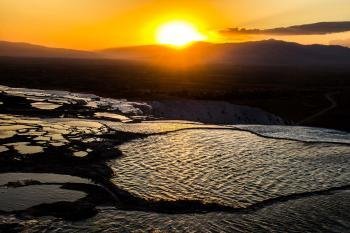
These days the ruins of Hierapolis are still there and are worth visiting. The hotels, on the other hand, have been completely demolished after it was decided they were causing too much damage to the site and the whole area was heritage-protected.
Whereas once you could swim in the travertines, now security guards keep a watchful eye on anyone trying to get too close. Other than a special swimming pool that has been constructed away from the cliffs, Pamukkale is generally to be seen but not touched these days.
In many ways, that’s to be applauded. The site is a truly remarkable natural phenomenon and it would be a pity if human interference damaged it permanently for future generations. There were certainly no complaints from anyone about taking their shoes off.
Keep reading 0 comments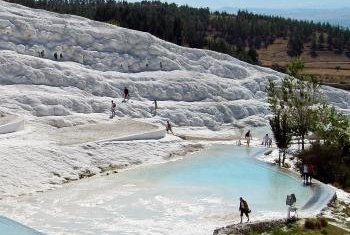
A friend living in Turkey recommended I add Pamukkale to my itinerary when I visited Turkey in 2007, and it was a great recommendation. The calcium terraces of Pamukkale are brilliantly white as you approach them from the village below, and I was in awe at the extent of the travertines. Visitors are required to remove shoes when wading up through the series of pools fed from the hot springs at the top of the hill. The water wasn't particularly hot--it was lukewarm at best--but the views from the terraces were spectacular. At the top of the hill was the Greco-Roman spa town of Hierapolis, because who wouldn't want to build an ancient resort in such a beautiful location! The ruins were typical of other Greco-Roman cities, and included a theater, an arcade, temples, and a necropolis. There was also a hot springs pool at the top of the hill, but unfortunately I didn't have enough Turkish lira available at the time to visit the pool.
Logistics: Train or bus to the city of Denizli; minibus from Denizli to the village of Pamukkale.
Keep reading 0 comments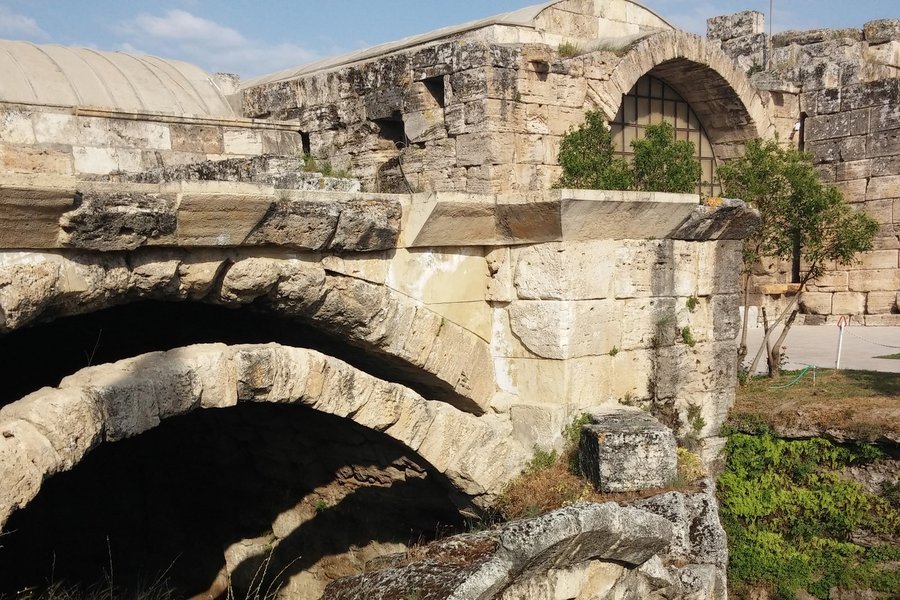
Too many tourists, too much money. 20TL to get into the site, 20TL to swim in the thermal pool. Hierapolis not the best ancient city - try Priene, even Ephesus (though that has even more tourists, make sure you get there late afternoon)
Keep reading 0 comments
Doug (USA)
Even 30 years ago the site of Pammukale had been ruined by too much tourism, destructive tourists and hotels, and a lack of mineral-laden water from which these formations were formed. On the other hand the site of Hieropolis is worth a visit. When I was there they were just begining to excavate the theater and there was an amazing amount of beautifully carved stone still in place. But the best reason to visit this city is the large necropolis. It has a wide variety of tomb styles not seen elsewhere and you can enter some of them and see where families had meals to celebrate their ancestors. Also there is a photogenic triple arch gate to the city.
Keep reading 0 comments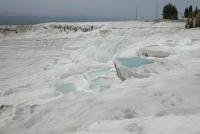
visited in 2000
The whiteness of the area was very hard on the eyes. Worthwhile to see, but I'm not too sure it's worth more than a pass thru.
The springs at the top were well worth the visit - My girfriend said it was like swimming in warm Perrier!
Keep reading 0 comments
Hierapolis and Pammukale are good places to visit in Turkey. Unfortunately they have begun to suffer from a bit of over-development. This is especially true of the travertine pools. They are now mostly dry and you can no longer bathe in them. Some of them are even artificial now! The ruined city, on the other hand, is pleasant. There are usually not big crowds and even if there are, you can escape them easily enough. The thermal pool at the top of the travertines is pricey (18 lira a pop), but worth it if it's not too crowded.
Keep reading 0 comments
